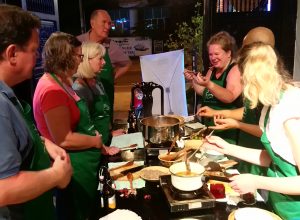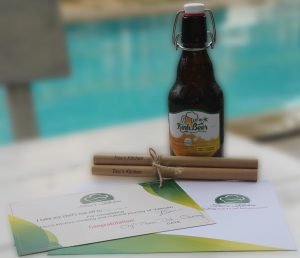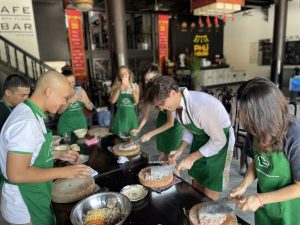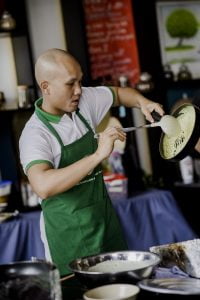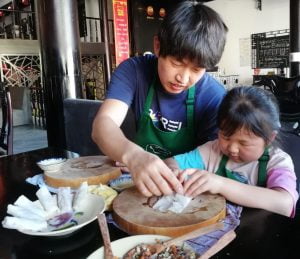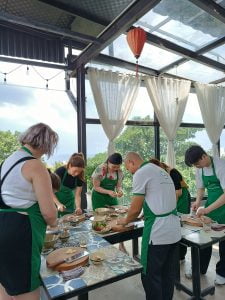PHO BO / PHO GA CLASS AT 10:00 AM – 14:00 PM
PHU QUOC COOKING CLASS
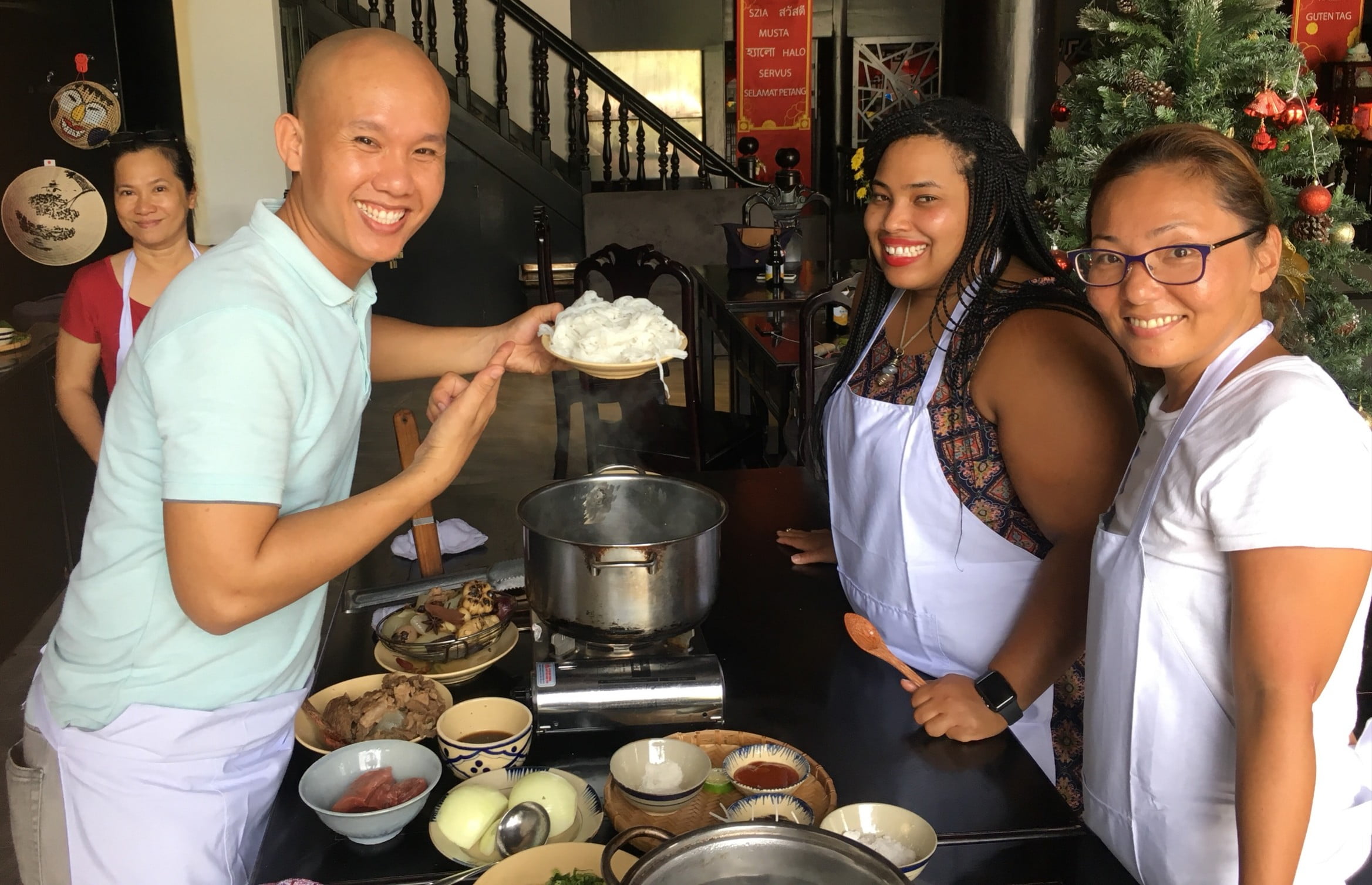
Vietnamese Pho cooking class in Phu Quoc . Learn how to cook the best Pho just in 4 hours with the secrets recipes of Troc .
For booking our Pho cooking class in Phu Quoc please contact and let us know your booking date and time so that we can prepare well for you . Please do not take to much breakfast or lunch before coming to our class.
- Troc’s Kitchen and cooking class team looking forward to do the special Pho cooking class in Phu Quoc with you .
TRADITIONAL BEEF NOODLE SOUP PHO COOKING CLASS PHU QUOC
Special pho classhttps://trocskitchenandcookingclass.com/phu-quoc-cooking-class/
Dear Foodies !
Pho cooking class in Phu Quoc with the Seaview which is the best experience during your vacation in Phu Quoc . Cooking a bowl of Pho with the Seaview it may bring more your experience with our to another level . We were really happy to share with you our authentic of the Traditional Vietnamese beef noodle soup ( Pho) at our Seaview class.
During the time to waiting for the broth of Pho is ready you will cook at least three more dishes .
If you are the fan of Vietnamese Pho and would like to bring it back to your your home please feel free to contact us directly to make the reservation to make one of the best Pho cooking class in Phu Quoc .
Troc’s Kitchen and cooking class team is looking forward to welcoming you to take part in our Pho cooking class in Phu Quoc .
INCLUDED HIGHLIGHTS OF THE PHO COOKING CLASS IN PHU QUOC
. Full ingredients
.Complimentary beverages
. Fruit plate
. Cooking certificate
. Intro to Vietnamese Cuisine ( the learners will get the chance to know Vietnamese coffee with our Chef )
.Learn from a professional Chef
. Small gift ( may be the Chef wil decide one extra dish for all the lerners to hands on )
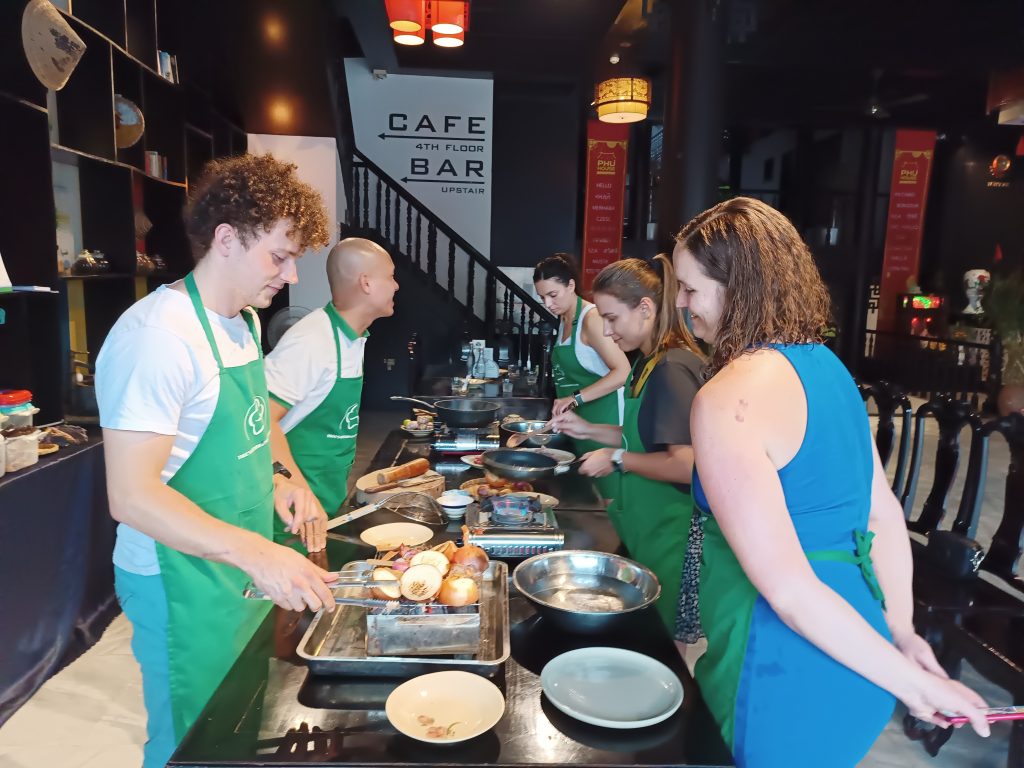
Our Foodies prepared for the ingredients of the Pho cooking class in Phu Quoc .
What is Pho ?
ALL ABOUT PHO! EVERYTHING YOU NEED TO KNOW
While traditional Pho cuisine is simple in theory, one thing we are sure of. This flavourful noodle-based soup has far surpassed the street vendors of Vietnam and earned its spot alongside popular around the world cuisine.
Whether you are new to the world of Pho or it happens to be your all-time favorite meal, visit for the best Pho in Phu Quoc , Kien Giang Province made by yourself with our team of your Pho cooking class in Phu Quoc .
History of Pho
Dating back to the 19th and 20th centuries, Pho (pronounced ‘fuh’) is considered the national dish of Vietnamese culture. It is made traditionally with beef or chicken broth and seasoned with an array of flavors and herbs. In the Western world, chefs and popular Pho connoisseurs have taken a more creative spin on the traditional dish.
The term “pho” actually refers to the noodles used in the dish, and not the soup combination itself. While there are several variations of soup dishes in Vietnamese food culture, pho is the only one that incorporates pristine white-flour noodles. The quality of pho can be judged by the broth. A great bowl of pho will be clear as crystal and packed with a ton of flavor.
Types of Pho
When it comes to pho, there are two basic types – Pho ga (chicken) or Pho bo (beef). Condiments for both of these mouth-watering soups include hoisin and lime sauce, chili sauce, and a sweet and spicy sauce made from vinegar, garlic, sugar, and soybeans. All we will show you more in our Pho cooking class in Phu Quoc . In your Pho cooking class in Phu Quoc with us we will show you how to make the best and easiest way for the condiments but it still authentic and effective.
- Phở, pronounced “Pho,” is a Vietnamese soup that is normally made with a bone-beef broth, banh pho noodles, and thinly sliced beef, that’s often served with bean sprouts and other fresh herbs on the side. Not to be confused with Japanese ramen, which is usually made with wheat noodles, pho is made with rice noodles. It is important to note that there are many variations of pho. The most common is pho Nam , which originates in Southern Vietnam, and pho Bac, which is from Northern Vietnam and considered to be the original pho or Pho Sai Gon the South of Vietnam Pho .
- Pho bo (beef pho) is usually served with a large bowl of broth and rice noodles and is accompanied by a plate of thinly sliced raw beef and a plate of fresh garnishes like basil, cilantro, radishes, chilies, and lime.
- Pho Ga is generally more straightforward than pho bo. Chicken is added to the broth, along with bean sprouts, vegetables, scallions, basil, chili, and coriander.
- At most pho restaurants, there are also several condiments on the table, such as hoisin sauce, soy sauce, fish sauce, Sriracha, and chili paste, to flavor the broth. Essentially, each bowl of pho is unique to you. With many different add-ins, you are able to adjust the pho to your preference. I recommend starting with adding raw meat to your broth.
- After adding the meat, add fresh garnishes of your choice. I prefer adding the aromatic herbs first, such as basil and cilantro, to allow the flavor of the herbs infuse with the broth. Next, I add the garnishes that provide extra texture to the pho, such as bean sprouts, radishes, and chilies. To top it off, I add any sauces or lime to my dish. I like adding chili paste, hoisin sauce, and a squeeze of lime .
- Pho Health Benefits
- Pho is more than just a tasty, comforting, and delicious soup – it also has a range of surprising health benefits. Consider limiting the sodium and noodles, while topping your dish with more vegetables, for a filling and nutritious low-calorie meal.
- Just a single bowl of pho can contain up to 30g of protein, equalling half of the recommended amount for a healthy adult. The traditional Vietnamese dish has also been said to do the trick if you feel like you are coming down with a cold, similarly to the American version of chicken soup
- What Makes Pho Special?
- The broth is what making pho special, and a good pho depends first and foremost on the quality of the broth. It’s the difference between a bad homemade pho and a good pho, a normal pho restaurant and really good one. So, if one knows how to make a good broth, then everything else is just a matter of getting the pho ingredients from the markets.
- Pho is not pho without its broth, it’s the vital element that gives pho its life and soul. If you can enjoy the pho broth wholeheartedly, then the rest of the ingredients in the bowl will be enjoyable and you will want to slurp up to the last drops.
- Variations of Pho
- Not a fan of beef? No worries! There are multiple variations of pho. The most common variations are pho ga (chicken pho) and pho chay (vegetarian pho). It is important to note, however, that not all Vietnamese noodle soup dishes are considered pho. For example, Bún Bò Huế ( Huế beef noodle soup ) is a pork base broth with rice noodles from the Hue region of central Vietnam and Hủ Tiếu is a pork and seafood noodle soup that is common in Southern region of Vietnam. Although these other dishes may look similar to pho, they differ in their flavors and are not always served with banh pho noodles (flat rice noodles). You will get more information during your time with us on doing Pho cooking class in Phu Quoc . Please feel free to ask.
How long to complete for the Pho cooking class in Phu Quoc ?
The Traditional Pho will take about at least 8-12 hours to cook for the broth can be full flavor . Contact us to arrange your Pho cooking class in Phu Quoc with the shortest time to learn how to cook pho https://trocskitchenandcookingclass.com/contacts-us/https://www.trocskitchen.com/contact-us to make the reservation of your Pho cooking class in Phu Quoc .
How Pho is Cook/ Pho cooking class in Phu Quoc cook?
From the early days when Pho first came to life, beef bones are left to boil and simmer in water on low heat for at least three hours, the scum and foam formed by excess grease from the bone marrow are skimmed to discard.
The process that pho is cooked largely varies on the skill and dedication of the person cooking it. Most pho recipes have many common elements between them, from the ingredients that go into the broth to the length of time required in making it. Troc’s Kitchen and cooking class team will ensure that after doing our Pho cooking class in Phu Quoc with us you find it convenient to flexible yourself .
Chef Troc at Troc’s Kitchen calls for the following ingredients to prepare for the Pho cooking class in Phu Quoc : ginger, shallots, yellow onions, marrow-rich beef bones and beef knuckle bones, star anise, cinnamon, salt, fish sauce, yellow rock sugar/ regular sugar, cloves, cardamom, scallion, cilantro and fresh rice noodles. If you want to try and make pho yourself, here’s a generic process to cook (pho bo )and cook (pho ga )at home after doing Pho cooking class in Phu Quoc .
Where Do We Eat Pho?
Though pho is the most popular breakfast in Hanoi / Saigon/ Phu Quoc , people rarely cook pho at home. Instead, they go a traditional pho restaurant to have a good pho. Perhaps, the amount of time it takes to cook the pho broth is what turning people off from trying to cook Pho at home. After doing Pho cooking class in Phu Quoc with us you can do again at home for sure .
As many pho lovers already know, it takes at least three hours to simmer a standard broth. A good broth usually requires the beef bones to be boiled gently for six to eight hours, high quality traditional pho restaurants are known to simmer the beef bones up to 12 hours or more!
Why do we need to boil the bones for so long? It’s because it takes time for the marrow in the bones to dissolve into the broth. A hard boil will distort the flavors of the pho broth.
How Troc will do the Pho cooking class in Phu Quoc with just 4 hours ?
This answer we will find out together on our Pho cooking class in Phu Quoc with Chef Troc .
How to order Pho?
When we recommend our Foodies to some of the famous pho restaurants in Phu Quoc , we see that ordering pho is really a perplexing matter to many foreigners. Especially, some pho restaurants inadvertently make their menus more complex than needed for travelers, making them like a mishmash of Vietnamese words.
Actually, it’s pretty easy to order pho at a local restaurant if you just keep these 2 things in mind: what meat do you want, and which part do you like.
- What meat do you want, beef pho or chicken pho?
As we talked earlier, there are two types of pho: pho bo and pho ga, or beef pho and chicken pho, respectively. Good pho restaurants in Phu Quoc serve only one type – either beef or chicken, so depending on the restaurant you come in – you can only order either beef or chicken. But you may also come across a hotel breakfast where they serve different kinds of Pho, including a vegetarian version. So, take your pick: beef pho or chicken pho. We definitely take note for you on our Pho cooking class in Phu Quoc .
- Which beef or chicken parts do you like?
With beef pho, restaurants in Hanoi/ Saigon serve a variety of beef parts for their customers to choose as the meat for the soup. The most basic meat is sliced rare beef steak, which is called “bo tai” or just “tai” in Vietnamese. It tastes great and represents the typical pho bo, so it’s ideal choice for most of our travelers . Pho bo also highly recommend on our Pho cooking class in Phu Quoc . Following is a pho cooking class Phu Quoc ( Beef Pho ) decoded menu:
- Phở tái – Sliced rare tenderloin, eye of round, or ribeye. ( Our favorite part using for our Pho cooking class in Phu Quoc ).
- Phở chín – Sliced well-done flank or brisket ( Our recommend at Pho cooking class in Phu Quoc )
- Phở tái chín – Rare and well-done beef (tasty combo)
- Phở nạm – Flank
- Phở tái nạm – Rare and Flank
- Phở vè dòn – Crunchy flank
- Phở gầu – Fatty brisket
- Phở gân – Tendon
- Phở sách – Tripe
Yet, you'd never guess but there are ways to further customizing your pho, if you want to tailor your own pho, just ask for any of the following:
- Nước trong – Non-fat broth (this is what everyone gets by default)
- Nước béo – Fatty broth, with extra fat.
- Ít bánh – Less noodle, “banh” refers to “banh pho” which is of course the pho noodle itself.
- Nhiều bánh – More noodle
- Ít thịt – Less meat
- Nước béo hành trần – Fatty broth with blanched onions on the side
- Không hành – No scallion
- Không hành tây – No onion
Condiments available at every pho restaurant:
- Nước mắm – Fish sauce for those who like more salty taste
- Quẩy – Fried breadsticks (extra order) for those who like to get very full
- Lime – For those who like a little citrus
- Garlic vinegar – Our favorite addition. Gives it a nice tangy touch!
- Chili sauce – These can vary in quality as some are homemade while others aren’t.
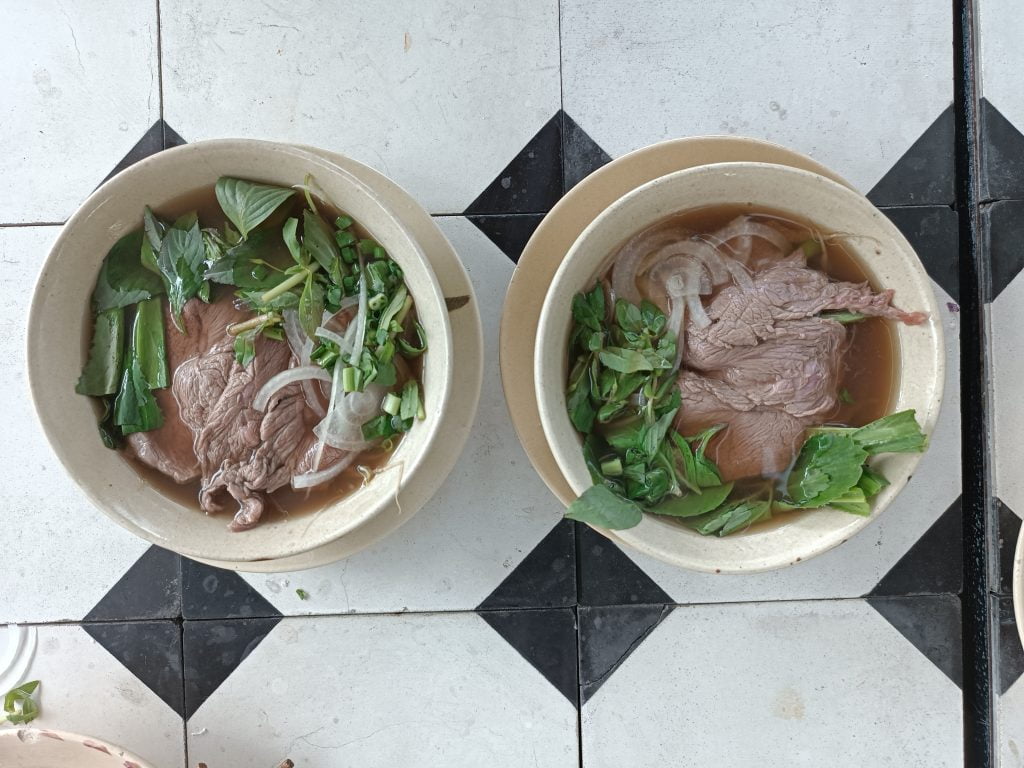
You're now ready for some real serious pho adventures in Hanoi/Sai Gon / Phu Quoc . For most of us, a regular bowl of pho bo is totally sufficient. But for a few, getting pho exactly right can only be achieved by ordering pho their own way. So have fun on your pho outing. For chicken pho, there are also a wide selection of chicken meat parts to go into your pho ga such as chicken thighs, chicken back, chicken wings, chicken neck, and organs such as heart and liver, even unlaid chicken eggs. When first visiting a chicken pho place and seeing all of these chicken parts on display, it seems strange to our travelers but it’s a commonplace in Hanoi/Sai Gon / Phu Quoc . We often mention to our Foodies that when we find a restaurant serving free-range chicken, and serves with a side dipping salt mixed with lime, minced ginger and sliced lime leaves, we are in a heaven! From our notice after years of taking travelers on our foodie experiences, among all the Vietnamese food that come to their radar, nothing else has received as tremendous acceptance as Pho. The dish captured the fascination of both Asian and Western travelers because of its deceptive simplicity and its complex flavors. For many Vietnamese, Pho is a perfect comfort breakfast, warm and deliciously refreshing. Well, hope our article post helps you with understanding a bit more about Pho – our national dish. Please contact us if you are looking for a private Phu Quoc cooking class with a real and professional Chef , we’re good at what we are doing and looking forward to showing you more about our Cuisine.

